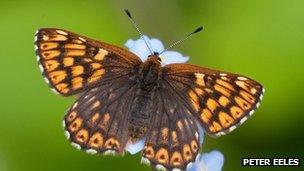Butterflies: 72% of UK species in decline
- Published

Duke of Burgundy butterfly in decline
Almost three quarters of UK butterfly species have declined in abundance over the past decade.
According to a study compiled by Butterfly Conservation and the Centre for Ecology and Hydrology (CEH), even common species have seen a fall of 24%.
It found that 72% of species had declined in abundance and that the distribution of 54% had been reduced.
Researchers say the loss of suitable habitats is thought to be the main reason for the declines.
However, conservation efforts have also helped some rare butterflies.
The study looks at data over 10 years, based on two long-running surveys. It analyses how many butterflies of each species there are and also looks at how their ranges have changed.
Among those showing the biggest declines were the Pearl-bordered Fritillary, the Duke of Burgundy and the High Brown Fritillary which saw a 69% fall in its population.
Some of the rarest species are particularly vulnerable to habitat loss as they need very specific conditions to thrive.
But the study also found that even common butterflies, including the Small Skipper, Common Blue, and Small Tortoiseshell saw declines over the decade.
Butterfly Conservation's surveys manager, Richard Fox, said: "It's sad and depressing that the numbers of habitat specialist butterflies are down.
"But it's particularly alarming that numbers of butterflies which are quite well adapted to living in a landscape that's highly modified by human management have decreased by nearly a quarter over a 10 year period."
The report also identifies success stories, where conservation work has helped some rare species to increase numbers.
Among them is the Large Blue, which was re-introduced in the UK in the 1980s after becoming extinct.
The key to re-establishing new colonies was an understanding of how its caterpillars are dependant on a particular species of ant.
The Marsh Fritillary and Small Blue have also seen increases in their numbers.
Dr Marc Botham, butterfly ecologist at CEH, said: "On a lot of local sites we've actually reversed these declines quite well.
"We've got a good understanding of the ecology and how to look after the habitat for these species. What we really need to do now is to expand this UK wide and look at this more broadly."
- Published2 November 2011
- Published16 September 2011